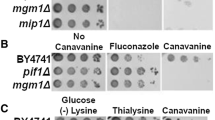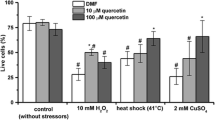Abstract
Oxygen is essential for aerobic organisms but causes cytotoxicity probably through the generation of reactive oxygen species (ROS). In this study, we screened for the genes that regulate oxidative stress in the yeast Saccharomyces cerevisiae, and found that expression of CTH2/TIS11 caused an increased resistance to ROS. CTH2 is up-regulated upon iron starvation and functions to remodel metabolism to adapt to iron starvation. We showed here that increased resistance to ROS by CTH2 would likely be caused by the decreased ROS production due to the decreased activity of mitochondrial respiration, which observation is consistent with the fact that CTH2 down-regulates the mitochondrial respiratory proteins. We also found that expression of CTH1, a paralog of CTH2, also caused an increased resistance to ROS. This finding supported the above view, because mitochondrial respiratory proteins are the common targets of CTH1 and CTH2. We further showed that supplementation of iron in medium augmented the growth of S. cerevisiae under oxidative stress, and expression of CTH2 and supplementation of iron collectively enhanced its growth under oxidative stress. Since CTH2 is regulated by iron, these findings suggested that iron played crucial roles in the regulation of oxidative stress in S. cerevisiae.








Similar content being viewed by others
References
Belli G, Molina MM, Garcia-Martinez J, Perez-Ortin JE, Herrero E (2004) Saccharomyces cerevisiae glutaredoxin 5-deficient cells subjected to continuous oxidizing conditions are affected in the expression of specific sets of genes. J Biol Chem 279(13):12386–12395. doi:10.1074/jbc.M311879200
Benov L, Fridovich I (1998) Growth in iron-enriched medium partially compensates Escherichia coli for the lack of manganese and iron superoxide dismutase. J Biol Chem 273(17):10313–10316
Care A, Vousden KA, Binley KM, Radcliffe P, Trevethick J, Mannazzu I, Sudbery PE (2004) A synthetic lethal screen identifies a role for the cortical actin patch/endocytosis complex in the response to nutrient deprivation in Saccharomyces cerevisiae. Genetics 166(2):707–719
Castells-Roca L, Muhlenhoff U, Lill R, Herrero E, Belli G (2011) The oxidative stress response in yeast cells involves changes in the stability of Aft1 regulon mRNAs. Mol Microbiol 81(1):232–248. doi:10.1111/j.1365-2958.2011.07689.x
Castells-Roca L, Pijuan J, Ferrezuelo F, Belli G, Herrero E (2016) Cth2 protein mediates early adaptation of yeast cells to oxidative stress conditions. PloS One 11(1):e0148204. doi:10.1371/journal.pone.0148204
De Freitas JM, Liba A, Meneghini R, Valentine JS, Gralla EB (2000) Yeast lacking Cu–Zn superoxide dismutase show altered iron homeostasis. Role of oxidative stress in iron metabolism. J Biol Chem 275(16):11645–11649
Evans MV, Turton HE, Grant CM, Dawes IW (1998) Toxicity of linoleic acid hydroperoxide to Saccharomyces cerevisiae: involvement of a respiration-related process for maximal sensitivity and adaptive response. J Bacteriol 180(3):483–490
Fendt SM, Sauer U (2010) Transcriptional regulation of respiration in yeast metabolizing differently repressive carbon substrates. BMC Syst Biol 4:12. doi:10.1186/1752-0509-4-12
Fenton HJH (1894) LXXIII.—oxidation of tartaric acid in presence of iron. J chem Soc Trans 65:899–910
Finkel T, Holbrook NJ (2000) Oxidants, oxidative stress and the biology of ageing. Nature 408(6809):239–247
Foury F, Talibi D (2001) Mitochondrial control of iron homeostasis. A genome wide analysis of gene expression in a yeast frataxin-deficient strain. J Biol Chem 276(11):7762–7768. doi:10.1074/jbc.M005804200
Fujii M, Adachi N, Shikatani K, Ayusawa D (2009) [FeFe]-hydrogenase-like gene is involved in the regulation of sensitivity to oxygen in yeast and nematode. Genes Cells 14(4):457–468
Fujii M, Miki K, Takayama S, Ayusawa D (2010) Identification of genes that affect sensitivity to 5-bromodeoxyuridine in the yeast Saccharomyces cerevisiae. Mol Genet Genom 283(5):461–468
Gardner PR, Fridovich I (1991) Superoxide sensitivity of the Escherichia coli aconitase. J Biol Chem 266(29):19328–19333
Goldring ES, Grossman LI, Krupnick D, Cryer DR, Marmur J (1970) The petite mutation in yeast. Loss of mitochondrial deoxyribonucleic acid during induction of petites with ethidium bromide. J Mol Biol 52(2):323–335
Grant CM, MacIver FH, Dawes IW (1997) Mitochondrial function is required for resistance to oxidative stress in the yeast Saccharomyces cerevisiae. FEBS Lett 410 (2–3):219–222
Hartman PS, Ishii N, Kayser EB, Morgan PG, Sedensky MM (2001) Mitochondrial mutations differentially affect aging, mutability and anesthetic sensitivity in Caenorhabditis elegans. Mech Ageing Dev 122(11):1187–1201
Ishii N, Fujii M, Hartman PS, Tsuda M, Yasuda K, Senoo-Matsuda N, Yanase S, Ayusawa D, Suzuki K (1998) A mutation in succinate dehydrogenase cytochrome b causes oxidative stress and ageing in nematodes. Nature 394(6694):694–697
Jamieson DJ (1992) Saccharomyces cerevisiae has distinct adaptive responses to both hydrogen peroxide and menadione. J Bacteriol 174(20):6678–6681
Kaida D, Yashiroda H, Toh-e A, Kikuchi Y (2002) Yeast Whi2 and Psr1-phosphatase form a complex and regulate STRE-mediated gene expression. Genes Cells 7(6):543–552
Keyer K, Imlay JA (1996) Superoxide accelerates DNA damage by elevating free-iron levels. Proc Natl Acad Sci USA 93(24):13635–13640
Leadsham JE, Miller K, Ayscough KR, Colombo S, Martegani E, Sudbery P, Gourlay CW (2009) Whi2p links nutritional sensing to actin-dependent Ras-cAMP-PKA regulation and apoptosis in yeast. J Cell Sci 122(pt 5):706–715
Liao X, Butow RA (1993) RTG1 and RTG2: two yeast genes required for a novel path of communication from mitochondria to the nucleus. Cell 72(1):61–71
Liochev SI, Fridovich I (1994) The role of O2.- in the production of HO.: in vitro and in vivo. Free Radic Biol Med 16 (1):29–33
Martinez-Pastor MT, de Llanos R, Romero AM, Puig S (2013) Post-transcriptional regulation of iron homeostasis in Saccharomyces cerevisiae. Int J Mol Sci 14(8):15785–15809. doi:10.3390/ijms140815785
Miki K, Shimizu M, Fujii M, Hossain MN, Ayusawa D (2008) 5-Bromouracil disrupts nucleosome positioning by inducing A-form-like DNA conformation in yeast cells. Biochem Biophys Res Commun 368(3):662–669. doi:10.1016/j.bbrc.2008.01.149
Philpott CC, Protchenko O (2008) Response to iron deprivation in Saccharomyces cerevisiae. Eukaryot Cell 7(1):20–27
Puig S, Askeland E, Thiele DJ (2005) Coordinated remodeling of cellular metabolism during iron deficiency through targeted mRNA degradation. Cell 120(1):99–110
Puig S, Vergara SV, Thiele DJ (2008) Cooperation of two mRNA-binding proteins drives metabolic adaptation to iron deficiency. Cell Metab 7(6):555–564. doi:10.1016/j.cmet.2008.04.010
Raguzzi F, Lesuisse E, Crichton RR (1988) Iron storage in Saccharomyces cerevisiae. FEBS Lett 231 (1):253–258
Rutherford JC, Jaron S, Winge DR (2003) Aft1p and Aft2p mediate iron-responsive gene expression in yeast through related promoter elements. J Biol Chem 278(30):27636–27643
Rutherford JC, Ojeda L, Balk J, Muhlenhoff U, Lill R, Winge DR (2005) Activation of the iron regulon by the yeast Aft1/Aft2 transcription factors depends on mitochondrial but not cytosolic iron–sulfur protein biogenesis. J Biol Chem 280(11):10135–10140. doi:10.1074/jbc.M413731200
Shakoury-Elizeh M, Tiedeman J, Rashford J, Ferea T, Demeter J, Garcia E, Rolfes R, Brown PO, Botstein D, Philpott CC (2004) Transcriptional remodeling in response to iron deprivation in Saccharomyces cerevisiae. Mol Biol Cell 15(3):1233–1243. doi:10.1091/mbc.E03-09-0642
Swanson WH, Clifton CE (1948) Growth and assimilation in cultures of Saccharomyces cerevisiae. J Bacteriol 56(1):115–124
Takayama S, Fujii M, Kurosawa A, Adachi N, Ayusawa D (2007) Overexpression of HAM1 gene detoxifies 5-bromodeoxyuridine in the yeast Saccharomyces cerevisiae. Curr Genet 52(5–6):203–211
Traven A, Wong JM, Xu D, Sopta M, Ingles CJ (2001) Interorganellar communication. Altered nuclear gene expression profiles in a yeast mitochondrial dna mutant. J Biol Chem 276(6):4020–4027. doi:10.1074/jbc.M006807200
Yamaguchi-Iwai Y, Dancis A, Klausner RD (1995) AFT1: a mediator of iron regulated transcriptional control in Saccharomyces cerevisiae. Embo J 14 (6):1231–1239
Acknowledgements
This work was supported in part by a Grant-in-Aid for Scientific Research from the Ministry of Education, Science and Culture of Japan.
Author information
Authors and Affiliations
Corresponding author
Additional information
Communicated by M. Kupiec.
Rights and permissions
About this article
Cite this article
Matsuo, R., Mizobuchi, S., Nakashima, M. et al. Central roles of iron in the regulation of oxidative stress in the yeast Saccharomyces cerevisiae . Curr Genet 63, 895–907 (2017). https://doi.org/10.1007/s00294-017-0689-4
Received:
Revised:
Accepted:
Published:
Issue Date:
DOI: https://doi.org/10.1007/s00294-017-0689-4




